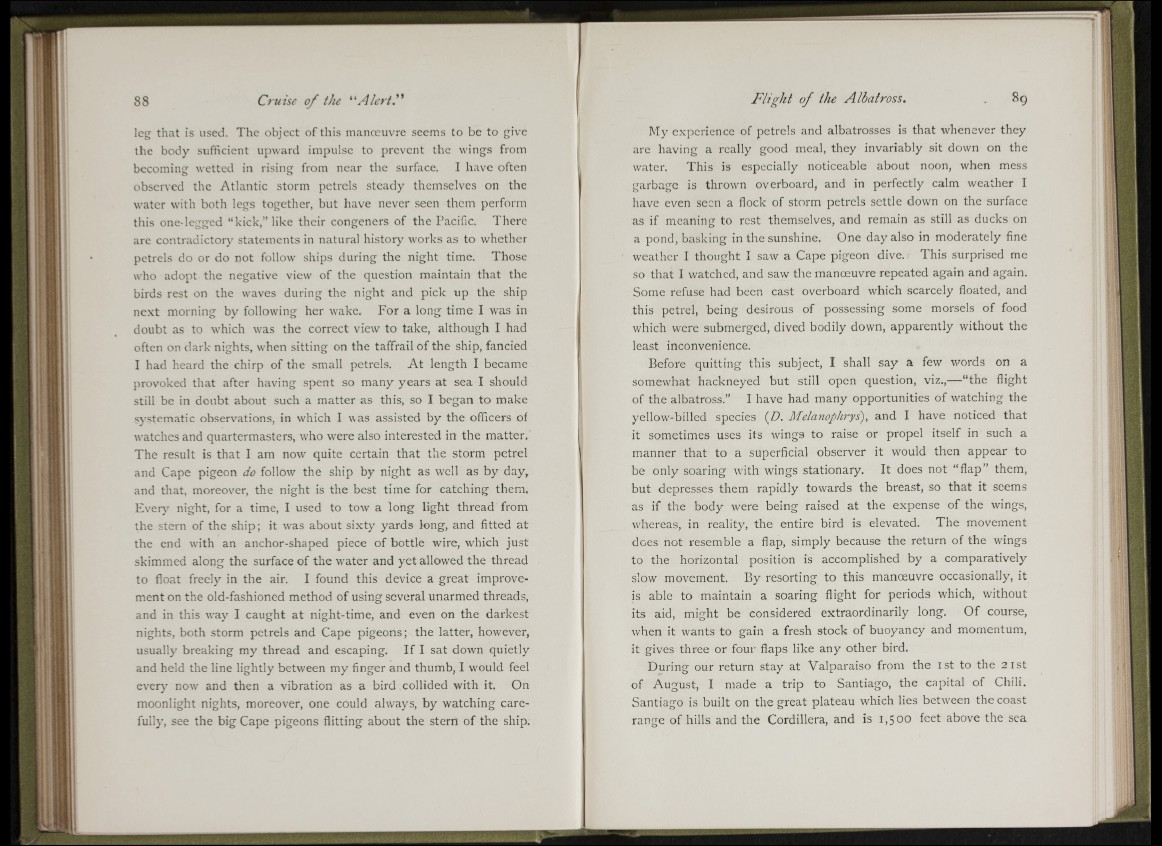
ilil
II
: U
leg that is used. The object of this manoeuvre seems to be to give
the body sufficient upward impulse to prevent the wings from
bccomincf wotted in rising from near o o the surface. I have often
observed the Atlantic storm petrels steady themselves on the
water with both legs together, but have never seen them perform
this one-lctrgcd “ kick,” like their congeners of the Pacific. Tlierc
arc contradictory statements in natural history works as to whether
petrels do or do not follow ships during the night time. Those
who adopt the negative view of the question maintain that the
birds rest on the waves during the night and pick up the ship
next morning by following her wake. For a long time I was in
doubt as to which was the correct view to take, although I had
often on dark nights, when sitting on the taffrail of the ship, fancied
I had heard the chirp of the small petrels. A t length I became
provoked that after having spent so many years at sea I should
still be in doubt about such a matter as this, so I began to make
systematic observations, in which I was assisted by the officers of
watches and quartermasters, who w'ere also interested in the matter.
The result is that I am now quite certain that the storm petrel
and Cape pigeon do follow the ship by night as well as by day,
and that, moreover, the night is the best time for catching them,
Even- night, for a time, I used to tow a long light thread from
the stern of the ship ; it was about sixty yards long, and fitted at
the end with an anchor-shaped piece of bottle wire, which just
skimmed along the surface of the w'ater and yet allowed the thread
to float freely in the air. I found this device a great improvement
on the old-fashioned method of using several unarmed threads,
and in this way I caught at night-time, and even on the darkest
nights, both storm petrels and Cape pigeons; the latter, however,
usually breaking my thread and escaping. If I sat down quietly
and held the line lightly between my finger and thumb, I would feel
everv now and then a vibration as a bird collided with it. On
moonlight nights, moreover, one could always, by watching carefully,
see the big Cape pigeons flitting about the stern of the ship.
My experience of petrels and albatrosses is that whenever they
arc having a really good meal, they invariably sit down on the
water. This is especially noticeable about noon, when mess
garbage is thrown overboard, and in perfectly calm weather I
have even seen a flock of storm petrels settle down on the surface
as if meaning to rest themselves, and remain as still as ducks on
a pond, basking in the sunshine. One day also in moderately fine
weather I thought I saw a Cape pigeon dive. This surprised me
so that I watched, and saw tlie manoeuvre repeated again and again.
Some refuse had been cast overboard which scarcely floated, and
this petrel, being desirous of possessing some morsels of food
which were submerged, dived bodily down, apparently without the
least inconvenience.
Before quitting this subject, I shall say a few words on a
somewhat hackneyed but still open question, viz.,— “ the flight
of the albatross.” I have had many opportunities of watching the
yellow-billed species {D. Melanophrys), and I have noticed that
it sometimes uses its wings to raise or propel itself in such a
manner that to a superficial observer it would then appear to
be only soaring with wings stationary. It does not “ flap” them,
but depresses them rapidly towards the breast, so that it seems
as if the body were being raised at the expense of the wings,
whereas, in reality, the entire bird is elevated. The movement
does not resemble a flap, simply because the return of the wings
to the horizontal position is accomplished by a comparatively
slow movement. By resorting to this manoeuvre occasionally, it
is able to maintain a soaring flight for periods which, without
its aid, might be considered extraordinarily long. Of course,
when it wants to gain a fresh stock of buoyancy and momentum,
it gives three or four flaps like any other bird.
During our return stay at Valparaiso from the ist to the 2is t
of August, I made a trip to Santiago, the capital of Chili.
Santiago is built on the great plateau which lies between the coast
range of hills and the Cordillera, and is 1,500 feet above the sea
‘I \ i|
" I
; r I*!
1 J
ri;
i u, r
I:
• -I
- I